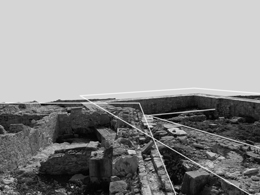STUDENTS PROJECTS
PROJECTS2015

01 July, 2016
Revealing Geometries
Amathus: a contemporary approach to the ancient city.
Students : Eftychios Savvidis
Supervisor: Ariadni Vozani
Consultants: Panayiotis Vasilatos, Anna Sbokou
National Technical University of Athens / School of Architecture
Presentation date : April 1st 2015
Having to deal with a rather peculiar and complex place, a new way of approaching, reading, comprehending and interpreting it, is attempted. Following secret and invisible traces of the past, a whole new condition is evoked and placed in space as it never existed before, while uncovering geometries and revealing accumulated inscriptions that molded and formed the landscape for ages.

It is about Amathus. The capital city of one of the eleven ancient kingdoms of the island of Cyprus, a place that once was one of the three larger cult centers of goddess Aphrodite, and also the place where, according to Plutarch, mythical Ariadne was buried, after she was abandoned there by Theseus. A vast amount of ancient texts and references had depicted and formed a blurry image of the city, before it was brought back to sight at the end of the previous century.
Starting in 1975, École française d'Athènes under the direction of Pierre Aupert begins its excavational expeditions in situ, revealing large parts of the lost and forgotten capital city. Among huge amount of findings that today adorn collections of the biggest museums around the world (such as the MET, le Louvre, the British Museum and the Neues Museum), the most important arouse to be those revealed on the acropolis on top of the hill, those in the lower city level around the ancient agora, as well as those lying underneath water into the sea. All significant in forming and deciphering the tumultuous history of this great kingdom, that seemed to be hosting human presence already since 1100 B.C up until the 7th century's Arabs' crusades, where it was left destroyed and deserted.
As a place that constantly embodied alterations and accepted "inscriptions" throughout the ages, today it is considered as one of the islands' great cultural and archaeological sites, whereas it is only partially showcased. Just the part of the ancient agora functions as a visitable archaeological site and the rest of the findings just lay around in a natural and intact landscape. What was once significant, today comes to be nothing more than a residual decorative element that slides into oblivion and withering, trying to survive in the urban and touristic suburbs of a big city. The last "virgin" and intact landscape, a rocky scenery filled with agaves and cyclamens...
Current issues, such as the luck of the whole monument in contemporary times, and a series of concerns and considerations around its rescue, its protection and preservation, its exposure, its reactivation its reinterpretation and its place and redefined role in the contemporary city come to the fore.

Fascination and intrigue accompanying a closer and detailed look and observation on the palimpsestic and complex, yet mysterious nature of the remains and the archaeological findings urged the initiation of a need for deciphering the layered and superimposed inscriptions of different condensed historical phases and time periods.
A series of incomprehensible correlations, unexpected conjugations, unexplained contradictions and strange deviations, gentle annexations and violent impositions, all summing up to a genius complexity that depicts the flux of history in the best possible way.
The way of carefully "reading" and interpreting the place, defined or better determined the method and the nature of the intervention. An intervention that takes into consideration the monumentality and the significance of such a site, and while remaining consistent to laws, legislations, charters, declarations and texts referred on architectural heritage, insists on creating a new situation and on imposing some new conditions on the place itself. An intervention described as being allusive towards layering, archaeological stratigraphy and the laws of superposition, aims on revealing geometries, bringing back to sight invisible traces of the past, and charging the place with the notion of time.
A system of laws, principles and tools is set up, and by the use of light and minimum gestures, a new text layer is created that allusively would reveal and state all the previous ones.
Metal poles carrying laser light pointers are placed on the intersections of different historical grids, emitting white laser light beams on specific directions, thus recreating the grids for different historical periods. Laser grids and meshes hovering on three different levels, alluding to three discrete historical phases, can be disturbed and disrupted and then back again appeared. (i)
Light running on the ground, coincides with the grids and geometries of the remainings of the different eras. (L)
Routes having a distinct, discrete, and repetitive form starting up from the city or the coastline level enter the site joining preexistent and new grids, abut, hover, approach and deflect while manipulating sight and hosting human body experience. (B, R, V)
New conditions are settled in place. New identity is given to it. Deciphered and clarified, or even more complex and convoluted but certainly enriched in meanings and values, and filled with incentives. //

















